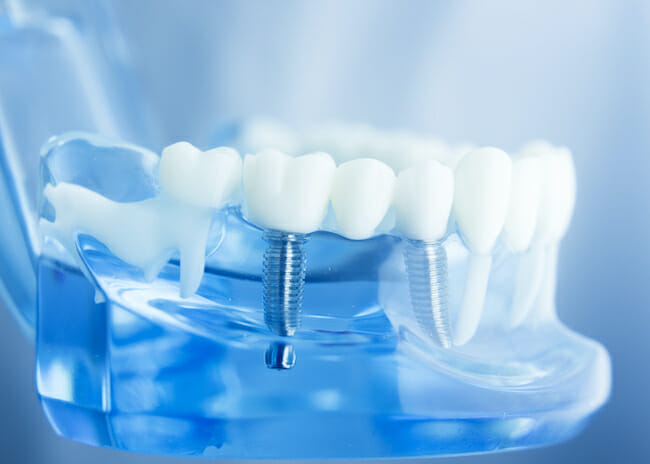Dental Implants Dayton, OH

What Are Dental Implants?
Dental implants are a permanent tooth replacement option. A dental implant consists of three parts:
- A screw-like anchor that mimics a natural tooth’s roots and holds the implant in place a patient’s jawbone
- A cap or crown that acts as the tooth replacement and blends in seamlessly with the surrounding teeth
- An abutment that attaches the crown to the anchor
Since they are anchored in the jawbone like a natural tooth, dental implants offer patients the most natural feel, function, and look of all tooth replacement options. Plus, they’re just like caring for regular teeth.
Why You Should Replace Missing Teeth
While most patients automatically want to replace a tooth that’s missing from the visible portion of the mouth, many often wonder what the point is of replacing teeth missing from the back of the mouth. However, there are reasons why you should replace missing teeth that aren’t purely cosmetic:
Protect Your Jawbone
The pressure placed on your jawbone when you bite down a tooth stimulates the production of new bone matter. When you lose a tooth, the jawbone beneath the open space does not receive the same pressure and stimulation. As a result, the bone begins to deteriorate over time. This not only changes your appearance but also negatively affects neighboring teeth.
Prevent Shifting
When left unreplaced, neighboring teeth begin to shift, moving into the space left open by the lost tooth. This leads to malocclusion (problems with your bite) and a changed appearance.
Protect Neighboring Teeth
A missing tooth can also lead to damaged neighboring teeth as a result of the shifting, jawbone deterioration, and excessive wear and tear placed on them when chewing.
Restore Function
A missing tooth can also affect the function of your mouth, making it difficult to speak, eat, and drink normally.
The Implant Placement Process
Our dental team handles the entire implant placement process, which begins with an initial patient consultation. The actual process of implant placement can be fairly lengthy, taking several months, depending on each patient’s needs, oral health, and jawbone mass.
Jawbone Preparation
If necessary, the process begins with a bone graft procedure and a healing period to bolster the jawbone so that it’s strong enough to support a dental implant.
Anchor Placement
Once healed, the dental implant is placed in another surgical procedure followed by another healing period when the anchor undergoes an osseointegration process with the jawbone.
Abutment and Crown Placement
Once stable, the abutment and dental crown are finally placed. Depending on how your gums heal around the anchor, the abutment and dental crown might be placed during separate appointments.
Am I a Candidate for Dental Implants?
Although dental implants are a wonderful option for replacing missing teeth, they aren’t right for everyone. To receive a dental implant:
- You must be healthy enough to undergo a surgical procedure under general anesthesia.
- You must have generally good oral health with no signs of periodontal disease.
- You must have a large enough and strong enough jawbone to support the implant anchor.
To find out if you’re a good candidate for dental implants or to learn more about tooth replacement options, we welcome you to schedule a tooth replacement consultation at Steve A. Sato, DDS today.




